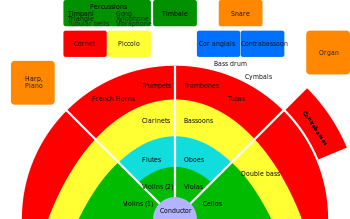Instruments of the orchestra
Meet the Instruments of the Orchestra
Dallas Symphony Orchestra Website

Orchestral layout
Learning Goals:
- Students can name the four families of the orchestra
- Students can identify and place individual instruments in the correct instrument family category
- Students can explain orchestra seating and arrangement
Lesson Introduction/Grabber: Teacher will ask students if they can name any musical instruments. After sharing; the students will watch the following video as an introduction to the orchestra
Meet the Instruments of the Orchestra
- Day 1
The teacher will divide the class into 4 groups; Each group will be assigned one of the families of the orchestra (strings, brass, percussion, woodwind). Using both the Dallas Symphony Orchestra Website and the Wikipedia Orchestra website, groups will work together to create a brief presentation on each family and the instruments within the families. The students will be allowed to use the smart board in order to present the sounds of the instruments.
- Day 2
Students will be given a post-it note containing the name of an instrument. The teacher will tell the students to find other students in the room that have instruments that belong in the same family and then they will sit in a group together.
The groups that were formed in task 2 are now teams. Each team will have a dry erase board and a marker; The teacher will, again, use the Dallas Symphony Orchestra Website to play an instrument sound (the students will not be able to see the screen). They will write the name of the instrument on their board for one point and if the family can be named; 2 points will be awarded.
- Day 3
Students will look at the following image of an orchestral layout
Students will then answer the following questions. Why do you think the violins and violas are in the front and the brass instruments are in the back? Why is it important for the conductor to stand in front of the orchestra? The students will then watch the orchestra video. Orchestral Performance
Assessment: Students will now work on an individual basis to aurally identify the name of the instrument and it’s family. Students will have a list of instruments on a piece of paper. Once they hear the instrument they will attempt to name and categorize the instrument. Student will then describe where the instrument might be placed in the orchestra
0-student could not identify
1-student completes one task (name, category or placement)
2-student completes two tasks (name, category or placement)
2-student can successfully name, categorize and place the instrument